The Intel Comet Lake Core i9-10900K, i7-10700K, i5-10600K CPU Review: Skylake We Go Again
by Dr. Ian Cutress on May 20, 2020 9:00 AM EST- Posted in
- CPUs
- Intel
- Skylake
- 14nm
- Z490
- 10th Gen Core
- Comet Lake
Power
We kind of gave a sneak preview on the front page with our frequency graph, but the short answer as to whether these new Core i9 processors really need 250 W for 10 cores is yes. Intel sent us details on what it has determined should be the recommended settings for its K processor line:
- Core i9-10900K: TDP is 125 W, PL2 is 250 W, Tau is 56 seconds
- Core i7-10700K: TDP is 125 W, PL2 is 229 W, Tau is 56 seconds
- Core i5-10600K: TDP is 125 W, PL2 is 182 W, Tau is 56 seconds
For those not used to these terms, we have the TDP or Thermal Design Power, which is meant to be the long-term sustained power draw of the processor at which Intel guarantees the base frequency of the processor – so in this case, the Core i9-10900K guarantees that with a heavy, long-running workload it will max out at 125 W with a frequency of at least 3.7 GHz (the base frequency).
The PL2 is known as the turbo power limit, which means that while the processor is allowed to turbo, this is the upper power limit that the processor can reach. As mentioned on the first page of this review, the value for PL2 is only a suggested guide, and Intel lets motherboard vendors set this value to whatever they want based on how well the motherboard is designed. Sometimes in laptops we will see this value lower than what Intel recommends for thermal or battery reasons, however on consumer motherboards often this value is as high as it can possibly be.
The final term, Tau, is meant to be a time by which the turbo can happen. In reality the TDP value and the Tau value is multiplied together to give a value for a ‘bucket’ of energy that the processor can use to turbo with. The bucket is refilled at a continuous rate, but if there is excess energy then the processor can turbo – if the bucket is being emptied at the same rate as it is refilled, then the processor is down at the long-term TDP power limit. Again, this is a value that Intel recommends and does not fix for the vendors, and most consumer motherboards have Tau set to 999 seconds (or the equivalent of infinite time) so the processor can turbo as much as possible.
Note, when we asked Intel about why it doesn’t make these hard specifications and how we should test CPUs given that we’re somewhat enable to keep any motherboard consistent (it might change between BIOS revisions) for a pure CPU review, the response was to test a good board and a bad board. I think that on some level Intel’s engineers don’t realize how much Intel’s partners abuse the ability to set PL2 and Tau to whatever values they want.
All that aside, we did some extensive power testing on all three of our CPUs across a number of simulation and real-world benchmarks.
Core i9-10900K Power
Through our tests, we saw the Intel Core i9-10900K peak at 254 W during our AVX2-accelerated y-cruncher test. LINPACK and 3DPMavx did not push the processor as hard.
The more real-world tests, AI Benchmark and Photoscan, showed that in a variable operation workload mixing threads, we are more likely to see the 125-150 W range, with spikes up to 200W for specific operations.
For users interested in the voltage for our Core i9-10900K, we saw the processor peak at 1.34 volts, however even during an AVX2 workload it was nearer to 1.25 volts.
Intel Core i7-10700K
The Intel Core i7-10700K is rated by Intel to have a peak turbo power of 229 W, however our sample peaked at 207 W during y-Cruncher. LINPACK achieved similar results, whereas 3DPMavx was nearer 160 W.
Our AI Benchmark power wrapper failed for the 10700K due to a configuration issue, but the Photoscan ‘real world’ power test put the processor mostly in the 100-125 W range, peaking just below 150 W in a couple of places.
Intel Core i5-10600K
Intel’s Core i5-10600K has a recommended PL2 of 182 W, but we observed a peak of 125 W in y-Cruncher and 131 W in LINPACK.
We actually saw our AI Benchmark real-world test hit 130 W as well, while Photoscan was nearer the 60-80 W range for most of the test.
The full set of power graphs can be found here:
In terms of overall peak power consumption, our values look like this:
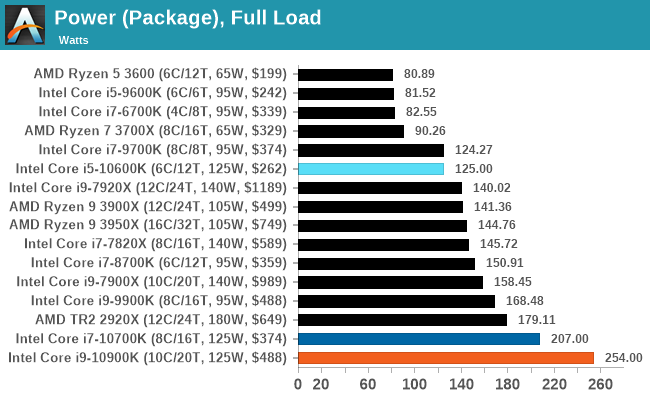
Note, 254 W is quite a lot, and we get 10 cores at 4.9 GHz out of it. By comparison, AMD's 3990X gives 64 cores at 3.2 GHz for 280 W, which goes to show the trade-offs between going wide and going deep. Which one would you rather have?



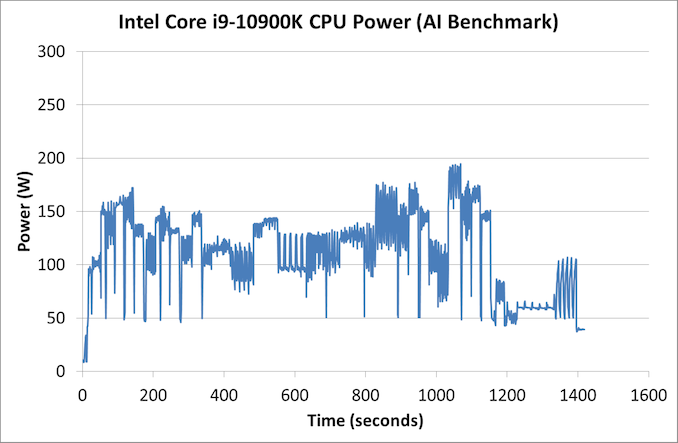
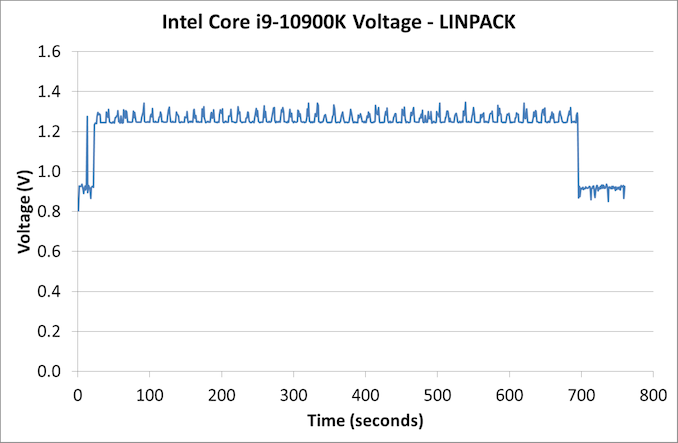
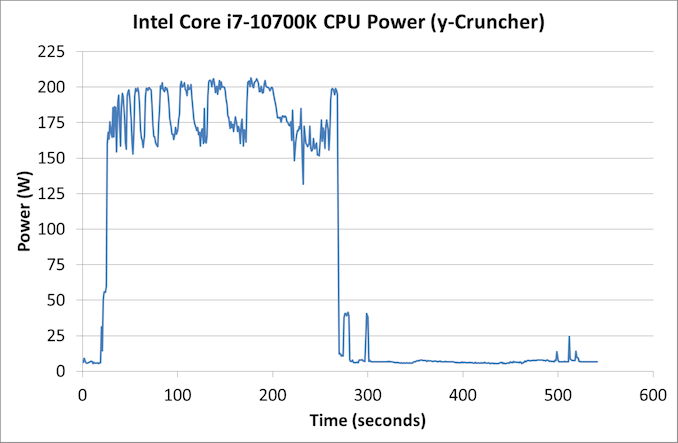
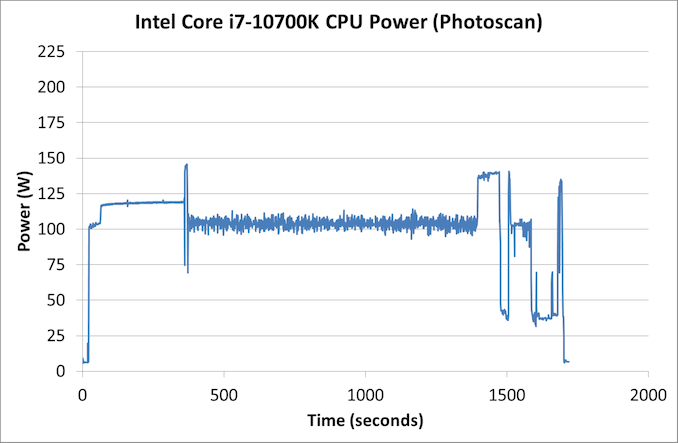
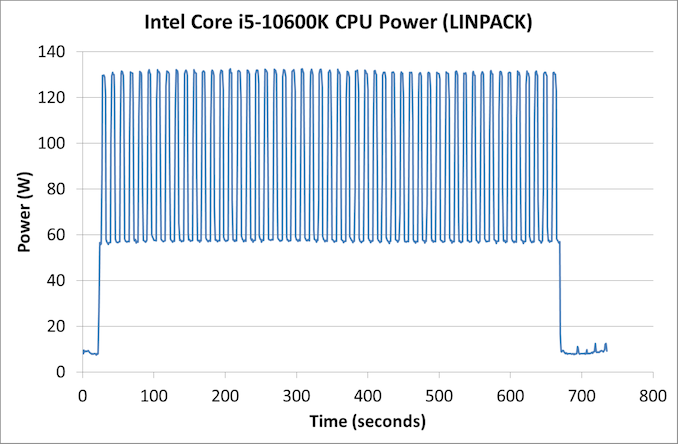
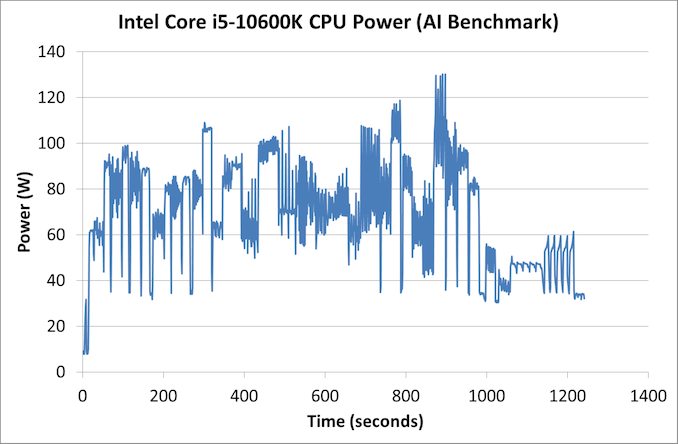














220 Comments
View All Comments
Boshum - Wednesday, May 20, 2020 - link
I generally agree, but I'm not so certain AMD will be in 2nd place within 5 years (from a best CPU architecture point of view). They should be considering the difference in resources, but Intel is so spread out and AMD seems so focused.poohbear - Wednesday, May 20, 2020 - link
OK i'll bite. Why would anyone buy this generation of Intel processors when AMD's is just as powerful and yet more efficient being on 7nm? Especially with Ryzen 4000 coming out this fall.dguy6789 - Wednesday, May 20, 2020 - link
AMD is ahead in a few key areas- price vs performance, total number of cores/threads, power.Intel is still ahead in the per core/per thread area. An Intel 8 core 16 thread will beat an AMD 8 core 16 thread in absolutely everything because of just how high Intel chips can clock to. In short, Intel is a higher performing albeit more expensive option for low thread count workloads.
Boshum - Wednesday, May 20, 2020 - link
I don't think the power and heat are too big a deal until you hit the 8 and 10-core K chips. The people that buy those are enthusiast gamers who want the highest possible FPS in games (whether they are able to perceive it or not, but I am sure they can in certain scenarios). A lot of those ultra-enthusiasts have a lot of fun with overclocking too, and Intel gets more out of that.Ryzen 4000 will undoubtedly be a better overall chip, but Rocket Lake should be coming to the LGA 1200 platform in the not too distant future. It may pass up Ryzen 4000 in gaming for those benchmark enthusiasts. It will be no match for Ryzen 4000 in heavy multi-core scenarios.
gagegfg - Wednesday, May 20, 2020 - link
At the end of the day, AMD continues to have the performance crown at a price premium (3950X).Also, it seems to me a bad ANANTECH policy for many graphics that do not have an AMD equivalent CPU and only put the 3600.
mandoman - Wednesday, May 20, 2020 - link
I can't imaging anyone being the slightest bit concerned about power on the HEDT! It's simply ludicrous to even bring it into the discussion. Frankly the whole emphasis in this review smacks loudly of "tree hugger" philosophy which has no place in the high end computing arena at all.Beany2013 - Wednesday, May 20, 2020 - link
Some of us actually care about good engineering rather than pushing an old, inefficient process node as hard as technically possible.Enjoy dropping an extra £100 just to cool your CPU.
Hxx - Wednesday, May 20, 2020 - link
WHAAT? U think this is not good engineering? this is BALLS engineering, they basically achieved a miracle on the 14nm platform. You are basically standing in front of a miracle. Step back and think about it. A 5 yo technology that competes and beats in many tests the competitor's 7nm process. Yes overall AMD may be the better purchase but again that not what im saying.Just think about that. On top of that they added good overclocking, controlled temps, plenty features, etc . Cant say im impressed with the Z490 platform itself since its the same old z390/70/270/170 with better connectivity but the CPU themselves will make history I mean the 14nm process sure is effing OLD but man what these guys did with this, the refinement it went through to achieve this performance on this OLD tech is amazing in my opinion and for that I applaud them. I want them to hurry up and wrap up Rocket Lake but this is definitely for sure no doubt definitely great engineering.
alufan - Thursday, May 21, 2020 - link
so what exactly do you think would happen if AMD did the same thing threw the power limits out the window and used a 14++++++ node with the extra thermal headroom available with the 3000 series chips, Intel has not released its new process node chips because they cant make them work AMD has and the limitations are simply due to the node size and physics, they have engineered a way round the issue Intel even now is talking about backporting designs it stinks, this is a "new" chip from Intel with more top end period AMD has released 3 nodes in 3 years and has a new version coming up in a few months with a rumored 20% uplift in IPC but lets wait and see, not to mention 5nm is designed and being sampled and 3nm is in design, that is EngineeringHxx - Thursday, May 21, 2020 - link
ROFL AMD? AMD struggles with getting a BIOS right let alone fine tuning a platform ? Nah they are too busy now supposedly giving us a beta bios for the 4xx series and that's a very scary thought given AMD's track record. In case you didn't know, AMD doesn't make their own chips. If tsmc moves to a different node then so will AMD, that's how it works. So yes I applaud TSMC for good engineering, AMD not so much.